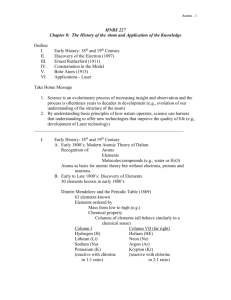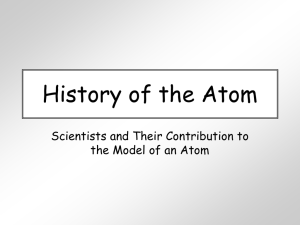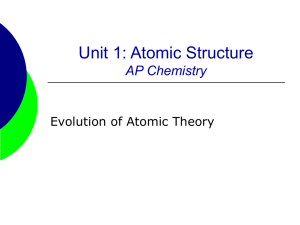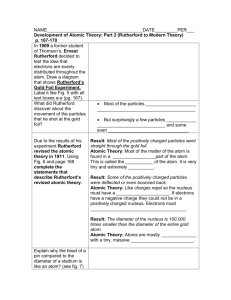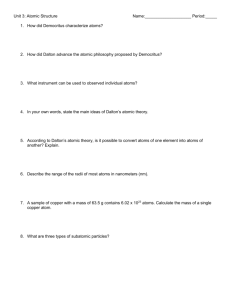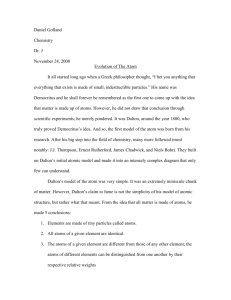Unit 04 Atomic Structure - Greenwich Public Schools
advertisement
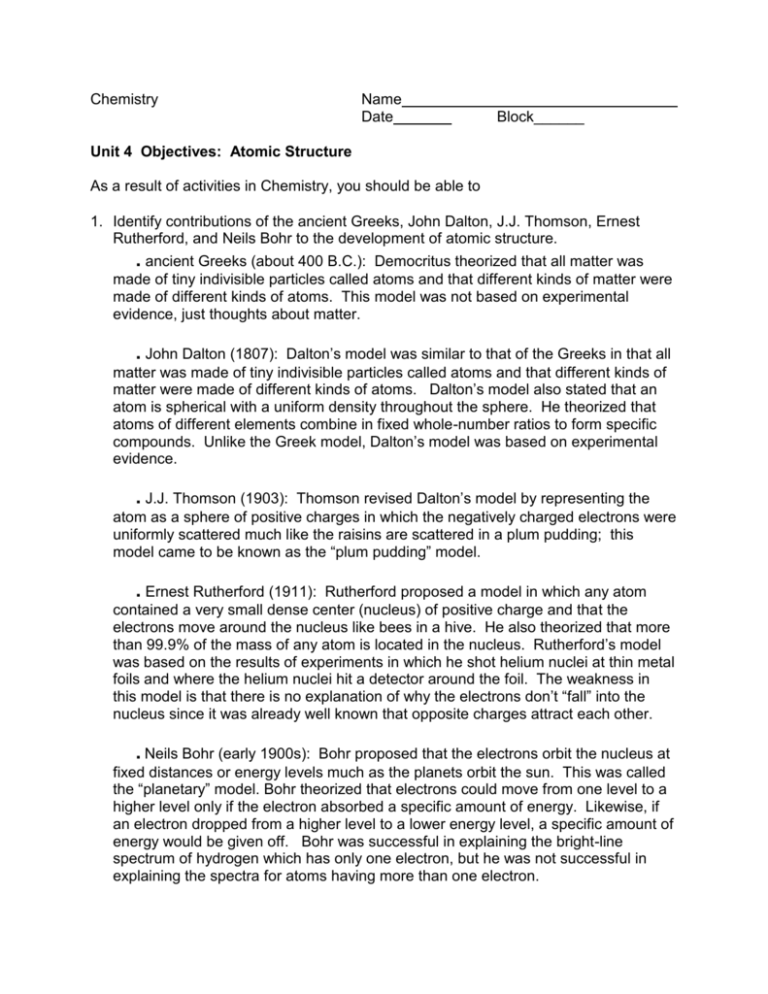
Chemistry Name Date Block______ Unit 4 Objectives: Atomic Structure As a result of activities in Chemistry, you should be able to 1. Identify contributions of the ancient Greeks, John Dalton, J.J. Thomson, Ernest Rutherford, and Neils Bohr to the development of atomic structure. . ancient Greeks (about 400 B.C.): Democritus theorized that all matter was made of tiny indivisible particles called atoms and that different kinds of matter were made of different kinds of atoms. This model was not based on experimental evidence, just thoughts about matter. . John Dalton (1807): Dalton’s model was similar to that of the Greeks in that all matter was made of tiny indivisible particles called atoms and that different kinds of matter were made of different kinds of atoms. Dalton’s model also stated that an atom is spherical with a uniform density throughout the sphere. He theorized that atoms of different elements combine in fixed whole-number ratios to form specific compounds. Unlike the Greek model, Dalton’s model was based on experimental evidence. . J.J. Thomson (1903): Thomson revised Dalton’s model by representing the atom as a sphere of positive charges in which the negatively charged electrons were uniformly scattered much like the raisins are scattered in a plum pudding; this model came to be known as the “plum pudding” model. . Ernest Rutherford (1911): Rutherford proposed a model in which any atom contained a very small dense center (nucleus) of positive charge and that the electrons move around the nucleus like bees in a hive. He also theorized that more than 99.9% of the mass of any atom is located in the nucleus. Rutherford’s model was based on the results of experiments in which he shot helium nuclei at thin metal foils and where the helium nuclei hit a detector around the foil. The weakness in this model is that there is no explanation of why the electrons don’t “fall” into the nucleus since it was already well known that opposite charges attract each other. . Neils Bohr (early 1900s): Bohr proposed that the electrons orbit the nucleus at fixed distances or energy levels much as the planets orbit the sun. This was called the “planetary” model. Bohr theorized that electrons could move from one level to a higher level only if the electron absorbed a specific amount of energy. Likewise, if an electron dropped from a higher level to a lower energy level, a specific amount of energy would be given off. Bohr was successful in explaining the bright-line spectrum of hydrogen which has only one electron, but he was not successful in explaining the spectra for atoms having more than one electron. . Modern Model of the Atom (from 1923 to the present): Based on experimental evidence and theoretical physics, the concept that particles could have properties of waves could be used to explain the behavior of electrons. Since this model describes the behavior of electrons in terms of quantized (having discrete amounts or quantities) energy changes, this model is known as the “quantum mechanical model.” 2. Define the atom as the smallest particle of an element that has the properties of the element. 3. Define an element as matter made of only one type of atom. 4. State the mass, electrical charge, and location in an atom of the proton, neutron, and electron. 5. State the results of changes in the number of subatomic particles: number of protons changed new element formed number of neutrons changed isotope formed number of electrons changed ion (charged particle) formed 6. Use the periodic table to determine the following characteristics of any electrically neutral atom: atomic number, mass number, number of protons, number of neutrons, number of electrons. 7. Determine the identity and basic structure (number of each subatomic particle) for an electrically neutral atom from maX notation (where m = mass number, a = atomic number, X = symbol of an element (e.g., 5224Cr)) and from X-m notation (e.g., Cr-52). 8. a) Define isotopes as atoms of the same element having different numbers of neutrons and therefore having different mass numbers. b) Identify isotopes based on maX notation and on X-m notation. 9. Determine average atomic mass of a given element using and masses and relative abundance of known isotopes.




